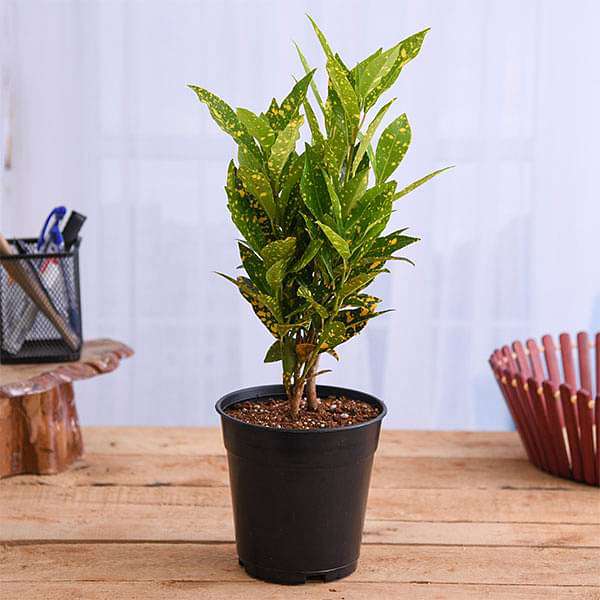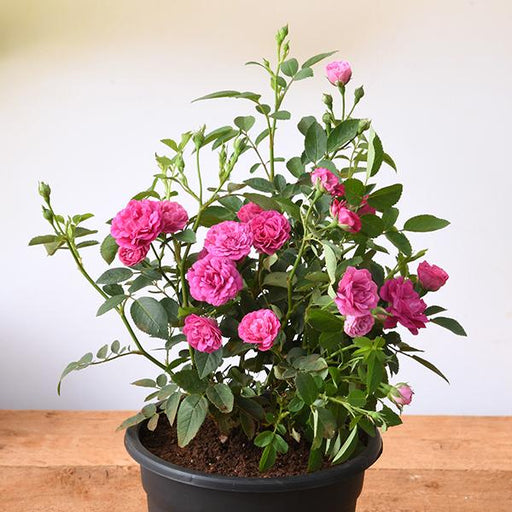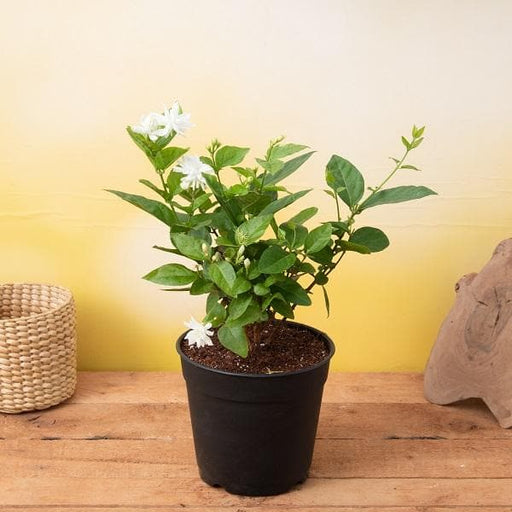
Croton Plant, Codiaeum variegatum (Gold Dust, Small Leaves) - Plant
(MRP Inclusive of all taxes)
- Shipping ₹79 for entire order
- Dispatch in 7 days
- Country of origin: India

(MRP Inclusive of all taxes)
 Save 29%
Save 29%
Air Purifier Money Plant with Pot The Air Purifier Money Plant, also known as Pothos or Epipremnum aureum, is a stunning indoor plant that...
View full details
 Save up to 15%
Save up to 15%
Peace Lily, Spathiphyllum - Plant The Peace Lily, scientifically known as Spathiphyllum, is a stunning houseplant celebrated for its elegant white...
View full details
 Save 25%
Save 25%
Jasminum sambac, Mogra, Arabian Jasmine - Plant Jasminum sambac, commonly known as Mogra or Arabian Jasmine, is a fragrant flowering plant...
View full details
 Save 18%
Save 18%
Combo Constituents Includes the Parijat Tree (Night-Flowering Jasmine), a culturally significant plant with fragrant flowers. Description The Pari...
View full details
 Save 25%
Save 25%
Miniature Rose, Button Rose (Any Color) - Plant The Miniature Rose, also known as the Button Rose, is a charming and compact flowering plant that ...
View full details Save 25%
Save 25%
Damascus Rose, Scented Rose (Any Color) - Plant The Damascus Rose, also known as Rosa damascena, is a timeless symbol of beauty and romanc...
View full details
 Save 17%
Save 17%
Beautiful Fragrant Mogra, Arabian Jasmine Plant with Pot The Beautiful Fragrant Mogra, also known as Arabian Jasmine (Jasminum sambac), is...
View full details Save 15%
Save 15%
Pack of Vermicompost and Neem Cake for House Plants Transform your indoor garden with our premium Pack of Vermicompost and Neem Cake, spec...
View full details
Pack of Plant Growth and Flower Boosters Unlock the full potential of your garden with our Pack of Plant Growth and Flower Boosters! This ...
View full details Save 38%
Save 38%
Combo of Jeevamrut and Neem Raksha for Easy Growth and Protection of Houseplants Transform your indoor garden with our exclusive combo of ...
View full details Save 22%
Save 22%
Plant Nutrients Kit (Pack of 16) for a Healthy Garden Transform your garden into a lush paradise with our Plant Nutrients Kit, featuring 1...
View full details Save 16%
Save 16%
Combo of Top Plant Fertilizers Elevate your gardening game with our exclusive Combo of Top Plant Fertilizers, featuring two bags of premiu...
View full details Save 24%
Save 24%
Pack of 4 Additives to Make Soil Healthy and Nutrient Rich Transform your garden into a thriving ecosystem with our Pack of 4 Additives de...
View full details Save 30%
Save 30%
Transform your gardening experience with our premium Combo of Perlite and Vermiculite. This unique blend is designed to enhance soil aeration and ...
View full details Save 27%
Save 27%
Combo of 2 Vermicompost and Cocopeat - Enrich Your Soil Naturally! Transform your garden into a thriving ecosystem with our Combo of 2 Ver...
View full details
 Save 35%
Save 35%
Best 6 Plants for Perfect Indoor Garden Transform your living space into a lush oasis with our curated collection of the Best 6 Plants for a...
View full details
 Save up to 50%
Save up to 50%
Mini Succulent Garden Pack Transform your space with our Mini Succulent Garden Pack, featuring a delightful collection of 4 any variety beautiful s...
View full details
 Save 30%
Save 30%
5 Best Fragrant Plants Transform your garden or indoor space into a fragrant paradise with our curated selection of the 5 Best Fragrant Plants. Th...
View full details
 Save 24%
Save 24%
Set of 2 Bonsai Looking Grafted Adeniums Transform your indoor or outdoor space with our exquisite Set of 2 Bonsai Looking Grafted Adenium...
View full details Save 45%
Save 45%
Top 4 Die Hard Succulents Pack Transform your indoor or outdoor space with our Top 4 Die Hard Succulents Pack, featuring a curated selecti...
View full details
 Save 30%
Save 30%
5 Best Indoor Plants Pack Transform your living space into a lush oasis with our '5 Best Indoor Plants Pack.' This carefully curated collection fe...
View full details
 Save 25%
Save 25%
Set of 4 Evergreen Air Purifier Plant Pack Transform your indoor space into a lush, green oasis with our Set of 4 Evergreen Air Purifier Pla...
View full details| SrNo | Item Name | Qty |
|---|---|---|
| 1 | Croton, Codiaeum variegatum (Gold Dust, Small Leaves) Plant in 6 inch (15 cm) Pot | 1 |
The Croton Plant, scientifically known as Codiaeum variegatum, is a stunning tropical plant celebrated for its vibrant foliage. The Gold Dust variety features small, glossy leaves adorned with a striking mix of green, yellow, and gold hues, making it a perfect addition to any indoor or outdoor garden. This plant thrives in warm climates and can grow up to 3 feet tall, adding a splash of color to your space.
What makes the Croton Plant special is its ability to adapt to various light conditions while maintaining its vibrant colors. This hardy plant is not only visually appealing but also purifies the air, making it a great choice for improving indoor air quality. Its unique leaf patterns and colors can vary significantly, ensuring that no two plants are exactly alike.
Special features of the Gold Dust Croton include its compact size, making it ideal for small spaces, and its resilience to drought once established. This plant is also known for its longevity, often thriving for many years with proper care. Its striking appearance and air-purifying qualities make it a favorite among plant enthusiasts.
The Croton Plant contributes positively to the environment by improving air quality through its natural filtration abilities. It absorbs carbon dioxide and releases oxygen, making it a valuable addition to any green space. Additionally, its vibrant colors can enhance biodiversity by attracting pollinators.
If you think caring for a Croton is as easy as pie, think again! This vibrant diva demands attention with its colorful leaves and unique personality. Water it just right, give it a sunny spot, and watch it thrive. But beware, overwatering is like giving it a bath it never asked for. Treat it like royalty, and it will reward you with a kaleidoscope of colors that will make your neighbors green with envy.
The Codiaeum variegatum family is like a box of chocolates—each one is unique and delightful in its own way. From the flamboyant Gold Dust to the understated Small Leaves, there’s a Croton for every taste. These plants are the fashionistas of the plant world, flaunting their colors and patterns like they’re strutting down a runway. Choose your favorite and let it be the star of your indoor jungle.
Want to multiply your Croton collection? Propagation is the name of the game! Snip a healthy stem, pop it in water, and watch as roots emerge like magic. It’s like giving birth to mini versions of your beloved plant. Just remember, patience is key—good things come to those who wait, and soon you’ll have a whole family of Crotons to show off.
While your Croton may look like a friendly housemate, it’s got a dark side. This beauty is toxic to pets and humans if ingested. So, if you have curious cats or dogs, keep this plant out of their reach. Think of it as the misunderstood villain in a movie—gorgeous but dangerous. Enjoy its beauty from a safe distance, and educate your guests about its toxic tendencies.
Crotons are sun worshippers, craving bright, indirect light to showcase their stunning colors. Place them near a window where they can soak up the rays, but don’t let them get sunburned! Too much direct sunlight can scorch their leaves, turning that vibrant green into a sad brown. It’s all about balance—like a tightrope walker, your Croton needs just the right amount of light to thrive.
When it comes to soil, Crotons are a bit picky. They prefer a well-draining potting mix that allows their roots to breathe. Think of it as their personal spa treatment—no one likes to sit in soggy soil! A mix of peat, perlite, and a dash of compost will keep your Croton happy and healthy. Remember, happy roots lead to happy leaves!
Crotons are tropical plants at heart, and they thrive in humidity. If your home is drier than a desert, consider misting your plant or placing it on a pebble tray filled with water. It’s like giving your Croton a mini vacation to the tropics! Keep the humidity levels up, and you’ll be rewarded with lush, vibrant foliage that will make your space feel like a rainforest.
Feeding your Croton is like treating it to a gourmet meal. Use a balanced liquid fertilizer during the growing season to keep those colors popping. Just don’t overdo it—too much fertilizer can lead to leaf burn, and nobody wants a crispy Croton. Think of it as a fine dining experience; a little goes a long way in keeping your plant healthy and happy.
Like any diva, Crotons can attract unwanted attention from pests. Aphids, spider mites, and mealybugs may try to crash the party, but with a little vigilance, you can keep them at bay. Regularly inspect your plant and give it a gentle wash to remove any intruders. Think of it as a spa day for your Croton—clean and refreshed, ready to shine!
Pruning your Croton is like giving it a stylish haircut. Trim away any dead or yellowing leaves to encourage new growth and maintain its shape. It’s a win-win situation—your plant looks fabulous, and you get to flex your gardening skills. Just remember to use clean, sharp scissors to avoid any plant drama. A little snip here and there can make a world of difference!
Beyond their stunning appearance, Crotons offer a plethora of benefits. They purify the air, boost your mood, and add a splash of color to any room. It’s like having a personal cheerleader in your home, brightening your day with every glance. Plus, they’re low-maintenance once established, making them the perfect companion for busy plant parents. Who wouldn’t want a little cheer in their life?
Ah, the Croton Plant, also known as Codiaeum variegatum, is a vibrant tropical beauty! With its dazzling gold-dusted leaves, it’s like nature’s confetti. This plant loves bright light and a bit of humidity, making it the perfect diva for your indoor jungle. Just don’t forget to give it a little love and water!
Caring for your Croton is like nurturing a high-maintenance friend. It craves bright, indirect sunlight and a warm environment. Water it when the top inch of soil is dry, but don’t drown it! Fertilize every month during the growing season, and watch it strut its colorful stuff.
Croton Plants are sun worshippers! They thrive in bright, indirect sunlight. Too little light, and they’ll sulk, losing their vibrant colors. Too much direct sun, and they might get scorched. Aim for a cozy spot where they can soak up the rays without getting fried.
Watering your Croton is a balancing act. Let the top inch of soil dry out before giving it a drink. Typically, this means watering every week or so, but it depends on your home’s humidity. Remember, it’s a tropical plant, not a desert dweller!
Croton Plants are tropical divas that love warmth! They thrive in temperatures between 60°F and 85°F (15°C to 29°C). Keep them away from chilly drafts and sudden temperature changes, or they might throw a tantrum and drop their leaves.
Absolutely! Propagating your Croton is like creating mini versions of your fabulous friend. Take a cutting with a few leaves, dip it in rooting hormone, and plant it in moist soil. Keep it warm and humid, and soon you’ll have a new plant to show off!
Leaf drop in Croton Plants can be a drama queen moment. It might be due to sudden temperature changes, overwatering, or not enough light. Check its environment and adjust accordingly. With a little TLC, your Croton will be back to its colorful self in no time!
Yes, the Croton Plant is a bit of a troublemaker! It contains compounds that can be toxic to pets if ingested. Keep it out of reach of curious paws and noses. If your furry friend takes a nibble, consult your vet for peace of mind.
Fertilizing your Croton is like giving it a gourmet meal! Use a balanced liquid fertilizer every month during the growing season. Dilute it to half strength to avoid overwhelming your plant. It’ll reward you with vibrant colors and lush growth, making it the star of your indoor garden!
Your Croton might attract some uninvited guests like spider mites, mealybugs, and aphids. Keep an eye out for tiny critters or webbing. If you spot them, a gentle wash with soapy water or insecticidal soap will send them packing. Your plant deserves a pest-free life!
Yes, but only if you live in a warm climate! Crotons love basking in the sun, but they can’t handle frost. If you’re in a cooler area, consider bringing them indoors during chilly months. They’ll appreciate the vacation and reward you with their stunning foliage!